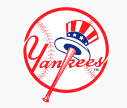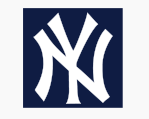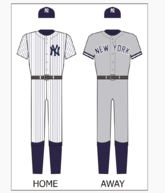
The New York Yankees are an American professional baseball team based in The Bronx borough of New York City that competes in Major League Baseball (MLB) in the American League's (AL) East Division. One of the AL's eight charter franchises, the club was founded in Baltimore, Maryland in 1901 as the Baltimore Orioles.[1] The team moved to New York City in 1903 and became the New York Highlanders, before taking the "Yankees" as their official name in 1913.[2]
The team is owned by Yankee Global Enterprises, an LLC controlled by the family of George Steinbrenner, who purchased the team in 1973. Former catcher Joe Girardi is the team's manager, andBrian Cashman is their general manager. Yankees home games were played at Yankee Stadium from 1923 to 1973 and from 1976 to 2008. In 2009, they moved into a new ballpark also called Yankee Stadium after the previous venue closed.[3] The team is perennially among the leaders in MLB attendance—in 2011, the Yankees had the second-highest attendance.
The Yankees have won 18 division titles, 40 AL pennants, and 27 World Series championships, all of which are MLB records.[4][5] Forty-four Yankees players and 11 Yankees managers have been inducted into the Baseball Hall of Fame, including Babe Ruth, Lou Gehrig, Joe DiMaggio, Mickey Mantle, and Yogi Berra.[6] In pursuit of winning championships, the franchise has utilized a large payroll to recruit talent, particularly under former owner George Steinbrenner. Due in part to their success, the Yankees have garnered enormous popularity worldwide and a dedicated fanbase, as well as widespread enmity from fans of other MLB teams; the Yankees' rivalry with the Boston Red Sox is one of the most well-known rivalries in sports.
History
Main article: History of the New York Yankees
Origins in Baltimore (1901–1902)
At the end of 1900, Ban Johnson, president of the Western League, a minor league, reorganized the league. He added teams in three east coast cities, forming the American League (AL) in an attempt to challenge the National League (NL) for supremacy. Plans to put a team in New York City were blocked by the NL's New York Giants, who had enough political power in New York City to prevent the AL from establishing a team. Instead, a team was put in Baltimore, Maryland, a city which the NL abandoned when it contracted from 12 to 8 teams in 1900.
Nicknamed the Orioles, the team began playing in 1901, and were managed and owned in part by John McGraw. During the 1902 season, McGraw feuded with Johnson, and secretly jumped to the Giants. In the middle of the season, the Giants, aided and abetted by McGraw, gained controlling interest of the Orioles and began raiding it for players, until the AL stepped in and took control of the team. In January 1903, a "peace conference" was held between the two leagues to settle disputes and try to coexist. At the conference, Johnson requested that an AL team be put in New York, to play alongside the NL's Giants.[7] It was put to a vote, and 15 of the 16 Major League owners agreed on it, with only John T. Brush of the Giants opposing. The Orioles' new owners, Frank J. Farrell and William S. Devery, found a ballpark location not blocked by the Giants, and Baltimore's team moved to New York.
Move to New York: the Highlanders years (1903–1912)
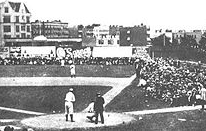
Hilltop Park, home of the Highlanders
The team's new ballpark, Hilltop Park (formally known as "American League Park"), was constructed in northern Manhattan at one of the island's highest points between 165th and 168th Streets, just a few blocks away from the much larger Polo Grounds. The team came to be known as the New York Highlanders for two reasons: it was a reference to the team's elevated location and to the noted British military unit The Gordon Highlanders, which coincided with the team's president, Joseph Gordon. As was common with all members of the American League, the team was called the New York Americans. New York Press Sports Editor Jim Price coined the unofficial nickname Yankees (or "Yanks") for the club as early as 1904, because it was easier to fit in headlines.[7][8]
The most success the Highlanders achieved was finishing second in 1904, 1906 and 1910, 1904 being the closest they would come to winning the AL pennant. That year, they would lose the deciding game on the last day of the season to the Boston Americans, who would later become the Boston Red Sox. This had much historical significance, as the Highlanders' role in the pennant race caused the Giants to announce that they would not play in the World Series against the AL pennant winner. The World Series would not be skipped again for another 90 years, when a strike truncated the entire 1994 season. It would be the last time Boston would beat New York in a pennant-deciding game for a full century (2004). 1904 was the year that pitcher Jack Chesbro set the single-season wins record at 41, which still stands. (Under current playing practices, this is most likely an unbreakable record).
New owners, a new home, and a new name: Years at the Polo Grounds (1913–1922)
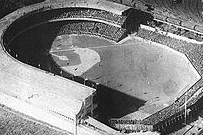
The Polo Grounds, home of the Yankees from 1913 to 1922
The Polo Grounds burned down in 1911 and the Highlanders allowed the Giants to play in Hilltop Park during reconstruction. Relations between the two teams warmed, and the Highlanders would move into the newly rebuilt Polo Grounds in 1913. Now playing on the Harlem River, a far cry from their high-altitude home, the name "Highlanders" no longer applied, and fell into disuse among the press. The media had already widely adopted the "Yankees" nickname coined by the New York Press, and in 1913 the team became officially known as the New York Yankees.
By the middle of the decade, Yankees owners Farrell and Devery had become estranged and both were in dire need of money. At the start of 1915, they sold the team to Colonel Jacob Ruppert and Captain Tillinghast L'Hommedieu Huston for $1.25 million.[9] Ruppert inherited a brewery fortune, providing the Yankees with an owner who possessed deep pockets and a willingness to dig into them to produce a winning team. This would lead the team to more success and prestige than Ruppert could ever have envisioned.
Sluggers and the Stadium: Ruth, Gehrig, and Murderer's Row (1923–1935)
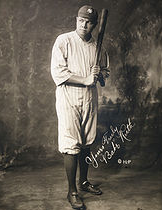
With his hitting prowess,Babe Ruth ushered in an offensive-oriented era of baseball and helped lead the Yankees to 4 World Series titles
In the years around 1920, the Yankees, the Red Sox, and the Chicago White Sox had a détente.[10] The trades between them, which antagonized Ban Johnson, garnered them the nickname the "Insurrectos".[11][12] This détente paid off well for the Yankees as they increased their payroll. Most new players who would later contribute to the team's success came from the Red Sox, whose owner, Harry Frazee, was trading them players for large sums of money. Pitcher-turned-outfielder Babe Ruth was the most talented of all the acquisitions from Boston, and the outcome of the trade would haunt the Red Sox for the next 86 years, a span in which the team did not win a single World Series championship. The Red Sox often found themselves eliminated from the playoff hunt as a result of the Yankees' success.[13] This phenomenon eventually became known as theCurse of the Bambino as the failure of the Red Sox and the success of the Yankees seemed almost supernatural, and seemed to stem from that one trade. However, it would not be until 1990 when Dan Shaughnessy ofThe Boston Globe wrote a book with the same title that the curse was publicized.[14]

Lou Gehrig was the first Yankees player to have his number retired, in 1939.
Ruth's multitude of home runs proved so popular that the Yankees began drawing more people than their landlords, the Giants.[12] In 1921, when the Yankees made their first World Series appearance against the Giants, the Yankees were told to move out of the Polo Grounds after the 1922 season. Giants manager John McGraw was said to have commented that the Yankees should "move to some out-of-the-way place, like Queens", but they instead broke ground for a new ballpark in the Bronx, right across the Harlem River from the Polo Grounds. In 1922, the Yankees returned to the World Series again, and were dealt a second defeat at the hands of the Giants. Important newcomers in this period were manager Miller Huggins and general manager Ed Barrow. The hiring of Huggins by Ruppert would cause a break between the owners that eventually led to Ruppert buying Huston out in 1923.
In 1923, the Yankees moved to their new home, Yankee Stadium. It was the first triple-deck venue in baseball and seated an astounding 58,000 people. In the first game at Yankee Stadium, Babe Ruth hit a home run, which was fitting as his home runs and drawing power paid for the stadium, giving it its nickname of "The House That Ruth Built".[7] At the end of the year, the Yankees faced the Giants for the third straight year in the World Series, and finally triumphed for their first championship. Prior to that point, the Giants had been the city's icon and dominant team. From 1923 onward, the Yankees would assume that role, and the Giants would eventually leave the city for San Francisco.
In the 1927 season, the Yankees featured a lineup that became known as "Murderers' Row", and some consider this team to be the best in the history of baseball (though similar claims have been made for other Yankee squads, notably those of 1939, 1961 and 1998).[15] The Yankees won a then-AL record 110 games with only 44 losses, and swept the Pittsburgh Pirates in the 1927 World Series. Ruth's home run total of 60 in 1927 set a single-season home run record that would stand for 34 years. Meanwhile, first baseman Lou Gehrig had his first big season, batting .373 with 47 home runs and 175 RBIs, beating Ruth's single-season RBI mark (171 in 1921). The Yankees would win the pennant and the World Series again in 1928.
In 1931, Joe McCarthy came in as manager, and brought the Yankees back to the top of the AL. They swept the Chicago Cubs in the 1932 World Series, and brought the team's streak of consecutive World Series game wins to 12. This series was made famous by Babe Ruth's "Called Shot" in game three of the series at Wrigley Field, a fitting "swan song" to his illustrious World Series career. Ruth would leave the Yankees to join the NL's Boston Braves after 1934, and would never see the World Series again.
Joltin' Joe DiMaggio (1936–1951)
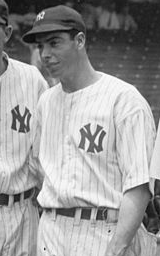
In 1941, Joe DiMaggio set an MLB record with a 56-game hitting streak
With Ruth retired, Gehrig finally had a chance to take center stage, but it was only one year before a new star appeared: Joe DiMaggio. The team would win an unprecedented four straight World Series titles from 1936 to 1939. For most of 1939, however, they had to do it without Gehrig, who was forced to retire because of Amyotrophic Lateral Sclerosis (ALS), now nicknamed "Lou Gehrig's Disease" in his honor. The Yankees declared July 4, 1939 to be "Lou Gehrig Day", on which they retired his number 4 (the first retired number in baseball). Gehrig made a famous speech in which he declared himself to be "the luckiest man on the face of the earth."[16] He died two years later.


